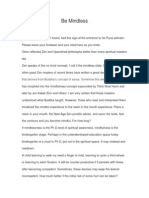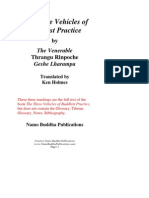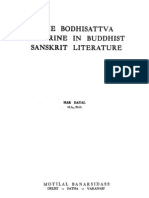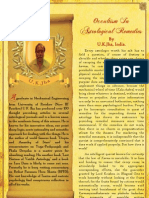What Is Nirvana - Part 2
What Is Nirvana - Part 2
Uploaded by
Martin SeidenstickerCopyright:
Available Formats
What Is Nirvana - Part 2
What Is Nirvana - Part 2
Uploaded by
Martin SeidenstickerOriginal Description:
Original Title
Copyright
Available Formats
Share this document
Did you find this document useful?
Is this content inappropriate?
Copyright:
Available Formats
What Is Nirvana - Part 2
What Is Nirvana - Part 2
Uploaded by
Martin SeidenstickerCopyright:
Available Formats
What is Nirvana: An Overview of the Various Views of nirvana in the Buddhist Tradition by Kyabgon Traleg Rinpoche Part 2
Nonabiding Nirvana During the first session we spoke about nirvana from the point of view of early Buddhism. Basically, everything I have said up to this point is based on these teachings. Now I would like to sketch you a general outline of the Mahayana understanding of nirvana. Mahayana means Great Vehicle. It is great in the sense of being more inclusive. One of the main visions or practices that characterize the Mahayana is the notion of including all sentient beings within the compass of ones own spiritual cultivation and development. In other words, when we embark on the spiritual path we dont do it only because we ourselves are suffering from the heat of samsara, which is too hard to bear as described earlier, but because we feel this is the condition that everybody else is in as well. If we desire happiness so does everyone else and if we ourselves want to be free from suffering then so do all other living creatures. Not just human beings but all living creatures, as we say all sentient beings. This is semchen tamche in Tibetan; semchen means ones with minds and tamche means all. In Buddhism we have a very different understanding of what mind is. We believe that even various animal species and so forth are also sentient creatures. I suppose these days, with our greater awareness of other living creatures welfare, our environment and so forth, this view is more congenial. We cant indulge in some kind of species chauvinism. We cant think, There is us human beings and then there are the rest. Anyway, the title the Great Vehicle means we want to take others along with us. We dont want to travel the path by ourselves, we want to drag others along kicking and screaming with us. Even if they resist, even if they say, We are happy in samsara. Please you go ahead and we will follow later. As Mahayana
Buddhists we are not supposed to be happy with that outcome. Instead we feel a responsibility to somehow bring happiness even to those that resist and so the Great Vehicle is embarked upon. We utilize the Great Vehicle to travel the bodhisattva path this is a Mahayana concept. As we were saying earlier, in Buddhism we believe in many different kinds of enlightenment and a series of stages of spiritual development. In Mahayana Buddhism we have the concept of the bodhisattva and not all bodhisattvas have the same status, the same calibre or the same bodhisattva level of realization. Some are more realized, or evolved, than others but they are collectively known as bodhisattvas because each of them has taken on the responsibility of doing things for the benefit of others, not only for themselves. They have embraced the Mahayana vision and taken on the bodhisattva precepts. Taking the bodhisattva vow or precepts means saying that from now onwards, what ever I do I will do it not only for myself, but also for others. Ten different stages of a bodhisattvas development are mentioned. We dont have to go into detail about them, but basically this suggests there are many different stages in the experience of enlightenment. Even at the first stage a bodhisattva is enlightened in his or her own right. After that it is just a matter of deepening and developing that attainment. Deepening and developing what has been realized at that point. This corresponds to what we said earlier about early Buddhist concepts of spiritual development. In early Buddhism when we embark on the spiritual path, first we become what are called stream-enterers jun shug in Tibetan. We enter the river of spiritual development. Then we become what is called a oncereturner. A once-returner is an individual who has advanced a great deal but still has some remaining karmic issues that need to be resolved. These saints are karmically compelled to return one more time, there is no choice involved, hence they are called once-returners. Developing from this stage the individual is then able to exhaust all the negative karmic traces and dispositions that bind them to the samsaric condition. Once these are severed or exhausted they do not have to return to the world if they do not wish, they are not karmically compelled to do so. Hence this individual is called a non-returner. The stage of non-returner is followed by full awakening, enlightenment the state of an arhat. In Mahayana Buddhism the whole approach is very different, in a way reversed. I should point out though that I dont think it is contradictory to have these
different approaches. It just means the nirvana we attain is contingent on the attitude and vision with which we approach, embark and travel on our spiritual path. In the Mahayana we do not aspire to attain nirvana, we do not try to attain the state of arhathood. As explained in the Mahayana literature we are not in a rush to attain nirvana, instead we try to defer nirvana. This is one of the main commitments of a Mahayana Buddhist practitioner, one who has the desire to tread the path of the bodhisattva. A bodhisattva is someone who has engendered the enlightened heart the enlightened attitude of wisdom and compassion. Such an individual does not want to run from samsaric turmoil at the first opportunity. Instead they want to remain in samsara and while doing so cultivate themselves through the practice of compassion. In Mahayana Buddhism the goal of the bodhisattva is not to rush toward nirvana nor continue to remain entangled in samsaric confusion. This is why the nonabiding nirvana is sought. Non-abiding nirvana is mi ne bai nyung de in Tibetan. Mi is a negating particle, ne means dwell or abide and nyang de means nirvana so mi ne bai nyang de means non-abiding nirvana. This nirvana is different from the nirvana that is escape from samsara. The nirvana we seek when trying to escape samsara is one of complete quietitude, where as the nonabiding nirvana is not a passive state. In the non-abiding nirvana, one engages in activity brought on by compassionate concern. It is said that the bodhisattva who is not in a hurry to attain enlightenment, takes three countless eons to become a Buddha. This may seem like a very, very long time and obviously it is, but I dont think we should take it too literally. Three countless eons countless, I think, says it all. How do you count three countless eons? The point seems to be that if we do not want nirvana selfishly for ourselves, if we relax and think about others, we will automatically approach nirvana. If we are hurrying, on the other hand then we are not going to succeed in attaining nirvana, which in the long run isnt going to be of benefit to either one self or others, in the full sense anyway. From the Mahayana point of view, a Buddha has realized three aspects of enlightenment, the three aspects of Buddhas being nirmanakaya, sambhogakaya and dharmakaya. The nirmanakya is the physical aspect of Buddhas being, the physical incarnation. The sambhogakaya is the communicative aspect of Buddhas being, it relates to the Buddhas wisdom. The dharmakaya relates to the Buddhas beingness in terms of how they remain in ultimate reality so there is no distinction between
dharmakaya and dharmadhatu. Dharmadhatu means ultimate reality. In Tibetan dharmadhatu is ch ying and dharmakaya is ch ku. I hope I am not burdening you with all these terms, but it is quite important to understand them. I think sometimes Western commentators say the dharmakaya is the cosmic body of the Buddha. This is not quite true. The dharmakaya means the Buddhas own being in him or herself. That is, not being separate from what in Buddhism is called emptiness. Emptiness is the ultimate reality and ones own subjective experience of that reality is realized as the dharmakaya. The sambhogakaya is the realization of wisdom. Of course wisdom can manifest in many different ways, it can take on a myriad of forms but generally four main kinds of wisdoms are spoken of. There is the wisdom of discrimination, the wisdom of equanimity, the wisdom of ultimate reality, and the wisdom of activity, which is sometimes translated as all accomplishing wisdom. In these ways the Buddhas wisdom manifests in a variety of ways as the most genuine authentic form of communication. This wisdom is communicated via the medium of the different qualities of wisdom that the Buddha possesses. The nirmanakaya is the transfigured form of the body. In Mahayana Buddhism we believe that an enlightened beings body is completely different to ours because it is not part of karmic causes and conditions. It is a transfigured body which the Buddha has also realized. A bodhisattva who is travelling on the Mahayana path wants to attain this state. They want to attain the three aspects of a Buddhas being, known as three kayas or ku sum in Tibetan. This state, however, can only be realized through the two accumulations of wisdom and merit. Merit is created through compassionate activities. These compassionate activities directly give rise to the physical aspects of a Buddhas being and wisdom gives rise to the mental aspects of Buddhas being. If we want to attain the three aspects of Buddhas being, we must practice compassion and accumulate wisdom, there is no other option. In this sense then we have to practice compassion. It is extremely altruistic and very noble to think of others but according to Mahayana Buddhism, in the long run, it is also in our own interest to think of others. It is a more elevated state of self interest, not a selfish one. This more noble perspective of self interest is attended to by thinking of others, because if we have compassion for others, if we do things for others, this will result in our attaining Buddhas physical aspect of enlightenment. By attaining this physical aspect of Buddhas enlightenment, we will not retire into the nirvana of quietitude but remain in samsara, remain in the world. While
remaining in the world, however, we will not be tainted by samsaric defilements. We will remain untainted because we have attained the mental aspects of Buddhas being the dharmakaya. In this particular instance, even the wisdom aspect is referred to as physical because it manifests in perceptible form to others. By attaining these two aspects of Buddhas being, one achieves the non-abiding nirvana. One does not remain in samsara because one has attained the Buddhas mental aspect and one does not remain in nirvana because of the Buddhas physical aspect. This physical aspect is then utilized in order to benefit sentient creatures with Buddhas infinite compassion. Buddha displays qualities of both compassion and wisdom. Wisdom allows the Buddha not to be tainted by the affairs of the world and compassion allows the Buddha to remain in the world as an extreme source of benefit and help to those still caught up in samsaric turmoil. In Mahayana Buddhism we have to introduce yet another concept regarding nirvana. As Mahayanists we believe Buddha was enlightened before he became enlightened in Bodhgaya. This is explained in many different Mahayana sutras. Are you falling asleep? I am having fun inside myself. Somebody told me there was a person at a party, and somebody came up to him and asked if he was having fun. He was not dancing or doing anything, just sitting quietly. He replied, I am having so much fun, I am dancing on the inside. So, I am like that now. Anyway, Buddha was enlightened before he was enlightened. Now we have to be very careful about this because if we take it too literally, if Buddha was already enlightened right from the beginning as it is said in some of the sutras, then at Bodghaya he was just sitting under the bodhi tree impassively. Then when he attained enlightenment he was just giving the appearance of being enlightened. It is said that Buddha was more or less pretending to become enlightened under the bodhi tree and was enlightened a long time before that, even before he was born. He even knew how to choose his future mother, where he was going to be born and so on. We need to think about this quite clearly because if this is the case then we have less hope. We have less hope of becoming enlightened, because Buddha had a head start. Dont you think so? He was in a completely different category than us. He was already enlightened and then, for our sake, so we dont feel too bad, he sits under this tree and says, I got enlightened this morning and everybody says, Oh wow, maybe we can try that as well, could you give us some tips on how to do that? Then Buddha proceeds to talk about the Four
Noble Truths. When we put it this way, I dont think we are supposed to take it too literally. In Mahayana Buddhism we have this concept of Buddha-nature. There are some schools of Buddhism that do not believe in Buddha-nature. All Mahayana schools, however, believe in bodhichitta and this bodhichitta has two aspects; one is called absolute bodhichitta and the other is called relative bodhichitta. I think we can say absolute bodhichitta and Buddha-nature is the same thing. We all possess Buddha-nature and Buddha-nature has never been corrupted by defilements, delusions, obscurations, or the two fold veils namely the veil of conflicting emotions and the veil of conceptual confusion.i Based on this understanding of Buddha-nature, we can say that our own nature is enlightened. This being the case then, in a manner of speaking, we are all intrinsically enlightened. We already have that spark of enlightenment. There are also slight differences in how this is interpreted. Some say Buddha-nature is just a spark and others say it is a state of complete enlightenment in its own right there is nothing that needs to be added to it or developed in it. Either way, a case can be made to say that our intrinsic primordial nature is enlightened. It is not a state of ignorance or delusion, it is more fundamental to our nature and our defilements are known as adventitious defilements. Being adventitious means the defilements we are tainted with are not part of our intrinsic nature, they are removable. They are non-essential elements which can be removed to allow the original purity of the enlightened state to be restored. In this way, in a manner of speaking, we have always been enlightened. To become enlightened then is to re-cognize. To recognize this lost insight. When we become enlightened it is not a new insight, it is a retrieval; something we have in a deep fundamental way is reawakened. I think that is what is meant by Buddha being enlightened long before he took physical form in his last incarnation. If we look at it in this way, Buddha was no different to us. We too have Buddha-nature and we too have the capacity to realize it. We have to realize these three aspects of Buddhas being in order to attain nonabiding nirvana, but to do this we need to overcome defilements. We have to cultivate compassion and develop wisdom, and in Mahayana Buddhism this is done with the practice of what is called the six paramitas generosity, moral ethics, patience, diligence, meditative-concentration, and wisdomawareness. Paramita means transcendental, so they are the six transcendental actions. These six paramitas are sort of the Mahayana equivalent of the Eight Fold Noble Path. They are similar because both the Eight Fold Noble Path and the six
paramitas train us in the three principal trainings moral precepts, meditative concentration and wisdom. With the first four paramitas we practice compassion. In Mahayana Buddhism we have to train in compassion but we shouldnt think that we know what compassion is or we find it a bit difficult to practice compassion. Rather we should realize that compassion is something we can train in. This means other practices, like mind training, are integral to Mahayana Buddhism. That is training the mind to become more accommodating to the development of altruistic and other regarding feelings and attitudes.ii These attitudinal changes are brought about by engaging in the six paramitas. Through the first four generosity, moral precepts, the cultivation of patience, and what is sometimes translated as effort and other times as vigour we practice compassion. We use concentration the fifth to practice compassion but we also use it to develop wisdom, because only a concentrated mind can think clearly and analyse things so with that one develops wisdom. What makes these practices transcendental is their wisdom element. Without it they are not transcendental, they remain just mundane. It is the mundane practice of observing moral precepts, or practising patience and so on. In Mahayana teachings, moral precepts have two components refraining from certain actions and engaging in others. First we have to learn restraint, then we have to be more forthcoming with the things that needs to be done. Patience in this regard does not mean patiently wait for something to happen or that we grin and bare even painful situations or experiences with a defeatist attitude, thinking we may just as well give in to the pressure, whatever it is. Instead, with wisdom and compassion we do not flinch from difficulties this is the point of patience. There is a heroic element to this form of patience where lifes challenges are faced willingly, instead of in a defensive, fearful and cowardly way. Not in an aggressive fashion or in a competition with adverse forces in which we try to come out on top, but rather in a skilful fashion, which is again a Mahayana concept that of skilful means. Skilful means is a technical term, thab kepa in Tibetan. We have to be very skilful in our dealings with these life situations. What is an appropriate response in one incident may not be appropriate in another instant. This shows the importance of the practice of meditative concentration and the cultivation of wisdom we need them badly even just to do something beneficial or nonharmful. Sometimes because we are not thinking clearly, are not focused enough,
dont have enough awareness, wisdom and understanding, we behave in an inappropriate fashion or respond to situations in an inappropriate manner. folly. This is what is meant by patience, because often I think we misunderstand what is meant by patience. Patience means we just have to bare it, we just have to put up with it because there are no other options. It is dealing with situations with a sense of courage and heroism without flinching, without backing down, without giving up. These are also all essential qualities for the would-be bodhisattva. In Tibetan a bodhisattva is called a chang chup sem pa. A pa or pawo is a warrior. Sometimes bodhisattvas are also called warriors spiritual warriors because they meet any challenge and deal with it in a skilful way. Vigour is also highly valued as part of the practice of compassion. Generally, not just in the West but generally, we do not associate these qualities as essential components of compassion. We think of compassion as this warm, glowing feeling a feel good kind of thing. I suppose how people used to feel when they were tripping out in the Himalayas in the 70s, This is far out man. Then you feel compassion for everything even the grass! When watching the grass grow you get all teary eyed. We have to understand that laziness, complacency, cynicism, lack of conviction all of these things are problems that dog us. We couldnt care less, we dont commit to anything enough. We just let our time pass and bungle our way through. I am sorry maybe you dont live like that, but many of us do I am sure. We lose great opportunities because we dont have a get up and go attitude and even when other people are doing something that may be beneficial we cannot rejoice. We make some cynical remark or say something bad to bring them down, when we ourselves are doing hardly anything. Vigour is a virtue in Buddhism, it is listed as one of the main virtues we need to develop. Effort may not be a very good translation because effort suggests we have to struggle and push ourselves and that is not necessarily what is meant. In the teachings this quality is described as looking at something, thinking it is really a good thing to do and really wanting to do it. We should think about that in such a way that it will bring us pleasure, it will give us a sense of satisfaction and if we associate doing something that is beneficial with that good feeling, a feeling of joy, then vigour will arise. This kind of thing is invigorating. As Shantideva starts the chapter on vigour in his Bodhisattvacharyavatara, tsn gang ge la tro wa o. By doing this we upset the whole thing and have to bare the consequences of that
Tsn means vigour, ge means beneficial activities, trowa means to take delight in it. So, tsn gang ge la trowa o means to take delight in all that is worth doing, in beneficial activities. If something is worth doing then it is not all that difficult to get joy from it. If we really think about it, if we see something is worth doing we will get satisfaction from doing it and that will be energizing. We will be invigorated and want to do more of the same. I hope I am making sense. Tsn gang ge la tro wa o means this really, Shantideva said it and it is part of the practice of compassion. When we are doing something beneficial for others this has to be supported by moral precepts, patience and vigour. We will have less success with these things if we cannot concentrate, if we are easily distracted. If we have a distracted mind it is very difficult to be consistent we cant follow things through, we leave them half done. This is because whatever grabs our attention we follow, if something happens, immediately we go after it. There is nothing to ground us. In spite of Buddhisms emphasise on impermanence, change and so forth we also emphasise centeredness. We have to have a centre, a sense of being grounded that we learn from meditation and concentration. Then we can use that same mind in our daily activities, we can do things with more efficiency and with a sense of excellence. Being able to concentrate in itself is not sufficient either, we have to have wisdom. In Mahayana Buddhism wisdom comes from being able to see interconnections, seeing connections where we do not usually see connections. We see things but we dont see connections. We see just separate individual things populating the world each a discrete, atomistic, separate, individual thing. We do not see inter-connections, we do not see inter-dependency. Wisdom comes from being able to see inter-dependency, and if we understand inter-dependency it is easier to develop compassion. If we think, for example, of the self as separate from other and the other as an objectively, self-sufficiently existing reality then between self and the other self-sufficiently, inherently existing reality there is no meeting point, there is no connection. Buddhism does not believe this to be true, according to Buddhism it is a fabrication. To see things in this way is a delusory state we have gotten ourselves into. To view things in this dualistic fashion subject and object, perceiver and the perceived, mental and physical is a fabrication. When we see inter-connections in things then we develop wisdom. We develop wisdom because how we see corresponds with how things are.
As things arise from dependent causes and conditions, nothing selfsufficiently exists. It is only our concepts that slice things up, put them into various categories to make sense of the world. Other than this, in reality, Buddhism says that everything is an interpenetrating, intersecting process. There are no static, inert things. Nothing has inherent existence because everything is nonsubstantial, empty of inherent existence. This is what emptiness means. Wisdom allows us to see emptiness and the inter-dependency of everything. Interdependency is ten drel in Tibetan and prattya samutpda in Sanskrit. Ten means dependence, when something needs another thing for it to exist. Drel or drel wa, means related, if two things are related it is called drel. In Mahayana Buddhism we try to understand this in relation to everything, including the self the subject. That is ones own consciousness, thoughts, ideas, feelings, memories, body everything and the actions we perform based on our attitudes, our intentions, all of these things are interdependent. We would have not come into being if it wasnt for something else. This was clearly analysed with great sophistication by Nagarjuna in his Mlamadhyaa krik. In this text, after analysing the self, the agent and the action he comes to the realization that even karma is not a reality that exists on its own. Even karma is empty of inherent existence its only there because of cause and effect. If they were not there, karma would not exist. Even karma has only conventional reality. If we understand that everything we experience, encounter, inter-act with or perceive does not have any inherent existence, then we have some understanding of wisdom. This wisdom is then carried into our compassionate activities so that everything that we do, we do with this understanding. We do them with an understanding of non-duality, with an understanding of the interdependency of everything. If there is inter-dependence then all kinds of things can be achieved. If there is no inter-dependency it would be very difficult for one thing to have effect on another. Two completely separate individual entities cannot have any real, significant impact on each other they would have nothing in common, they would have nothing to do with each other. This is not the case though, nothing on the physical and mental planes is free of this interdependence. Every thing, all dharmas as we would say in Buddhism, are part of this inter-acting network of causes and conditions and the process that every entity is subject to. All the physical and mental entities are called dharmas. The six paramitas are, in this way, wisdom and compassion, our helpers on the path. As we progress through the different bodhisattva stages all different kinds
of virtues are listed, but these paramitas are the most important ones. Again they are: to abide by moral precepts, to have patience, to be vigorous or energetic, to have a focused mind and to see things from a related point of view. This focused mind is characterized by the qualities of mindfulness and awareness. It is also free of two other mental states one is called stupor and the other is called mental agitation. Mental agitation is caused by worries, anxieties, excessive thinking getting embroiled in our conceptual proliferation. Meditative concentration helps us to develop mindfulness and awareness. It helps us to be free of stupor, agitation, and sceptical doubt. The Buddha himself said we should not take anything for granted, we should not take anything on hearsay, we should not take anything on authority, we should analyse everything by ourselves, which is true but often we carry it too far. We doubt everything and it is very difficult for us to gain real conviction in the things we have to have conviction in. Still we are completely gullible when it comes to other things that we should not be so gullible about. If a con-artist comes along and asks us to invest five thousand dollars because they are sure they can turn it into two hundred thousand in a month, we may think, This is a good idea and hand over the money. But when we hear teachings about karma and so forth we think, What! What is that about? Sceptical doubt really refers to spiritual matters that we find most difficult. Obviously it is not just us Westerners, living in the twentieth century, who have this difficulty either. Sceptical doubt is listed as a major problem in Buddhist teachings, so there must be a long history of doubting spiritual phenomena and spiritual realities. Whereas we have absolutely no problem about doubt when it comes to the samsaric illusion! We are taken in every time! As I mentioned, meditative concentration also has these qualities and it is followed by wisdom. When we have these, when we follow the path this way, then we are practicing compassion and wisdom at the same time conjoined. In the Mahayana teachings it is said that compassion and wisdom are like the two wings of a bird both are necessary. In the West, I think many people think Buddhism just emphasizes this contemplative aspect of spirituality, that it is not active, that it is not engaging. This is not true, obviously both are necessary. If we practice both, then we will realize the three aspects of Buddhas being, we will attain the non-abiding nirvana of Mahayana Buddhism that avoids the two extremes of nirvana quietitude and samsaric dis-quietitude. When one is in
possession of both wisdom and compassion, while remaining in the world one is not tainted by samsaric defilements. This is the goal. This is the Mahayana version of nirvana going beyond suffering. I think I have said what I wanted to say, and I may have said it for long enough as well. I think we will stop at this point and have a discussion. If you want to ask any questions you are welcome. Question: I have heard very often that in Mahayana Buddhism we have to transcend both samsara and nirvana, so is there something like a state that is beyond nirvana? Rinpoche: Well this is the thing, like I said before, there are many different kinds of nirvana. It depends on what sort of nirvana we are seeking. You are going to attain the nirvana you are looking for. In Mahayana Buddhism we are not looking for the nirvana of quietitude, we are looking for the nirvana that goes beyond samsara but does not completely exit the world. While inter-acting with other sentient creatures, one is in nirvana. Actually I didnt mention this, in relation to wisdom you also understand that samsara and nirvana are interdependent. This is what we understand in Mahayana Buddhism. Samsara and nirvana are not diametrically opposed, separate realms with no relationship. Samsara and nirvana are two sides of the same coin, so to speak. This is another insight that one gains in relation to the cultivation of wisdom. Samsara and nirvana have the same nature, they are imbued with the same reality. Samsara does not have one nature while nirvana has something else. Wisdom understands the non-duality of samsara and nirvana. Question: Right, so once you have reached that state..... so a Buddha wouldnt suffer any more if he sees the suffering of sentient beings. Is he completely devoid of that? Rinpoche: This is, I think, another very important point in Buddhism. We do not have any concept, in any form of Buddhism that says Buddha shares in the suffering of others. Buddha does not share suffering with other sentient beings but Buddha understands others suffering fully and is therefore able to aid sentient beings. Buddha, himself or herself, does not share in the suffering of other sentient beings because otherwise from a Buddhist point of view the whole spiritual journey would have been completely, totally, meaningless. Why
embark on a spiritual journey when at the end you find out that you couldnt overcome suffering after all? Why embark on a spiritual journey if even when you are not creating any suffering yourself, all these remaining sentient beings are making a mess of their lives so Buddhas have to suffer again? Buddhas understand others suffering for many reasons, because of their wisdom, because of their compassion and because Buddhas have also been ordinary sentient beings in the past so they know from their own experience what it is like to suffer. As I said before, even Buddha Shakyamuni should not be seen as someone completely unique, someone who was enlightened long before and only gave the appearance of becoming enlightened in his last incarnation. Buddha knows from experience what it is like to suffer, although Buddha is not currently suffering. I do not really think thinking that whoever is helping you also has to share in that suffering is very helpful. I dont think that is a helpful perspective to have. Some Christian theologies and Christian teachings say Jesus shared in our suffering, and this means that even God suffers with us. As Buddhists we disagree with that. We dont see any virtue in someone who is there to liberate us going through suffering with the very being they are trying to liberate. Question: My husband was a psychologist for a while and got quite burnt out because of the suffering. He was obviously feeling this very strongly. What advice do you have on how not to suffer with someone when you see somebody dissolving in tears in front of you and you feel incapable? How do you manage to detach yourself from that suffering? Rinpoche: I think this is why meditation is so important we have to have compassion and detachment at the same time. In Buddhism we cultivate detachment as well detachment but not indifference. Detachment is not indifference; we have to have concern for others, feelings for others. But these feelings for others should not become overwhelming. If we practice detachment we can keep the balance we require. Same student: But a lot of people do that, just cut off emotionally to protect themselves. Rinpoche: Yes, I know. This is the other extreme. In Buddhism, in terms of our view we try to maintain the middle view and in terms of our actions we try to follow the middle path. There is nothing spiritual about extreme, complete
detachment indifference, without any feelings, being cold. It is the anathema, the complete anathema, of any notion of becoming spiritually evolved. On the other hand if we allow ourselves to be knocked around by our strong emotions we are not in any better a position than the others we are trying to help. So we have to look at ourselves and think, Maybe I shouldnt be helping, maybe I should get help myself. If first I get myself a little bit together, I can help more. Do you know what I mean? I think this is a problem many people in helping professions face. Sometimes they have to listen to horrible, horrendous stories of peoples experiences. It is very hard to stay up beat when everything you hear is so bad, when it is always the same. After a while you may think the whole world is like that. That everybody is like this, everything is terrible and horrible and you may sink into a deep depression this also happens. This is why, I think, in Buddhism we need to have some kind of spiritual practice like meditation to keep ourselves centred and focused, aware and awake. When we have to deal with these issues, when difficult circumstances come along, then we can meet these challenges with even a little bit of wisdom and be a little more skilful. From the Buddhist point of view, when you are trying to help somebody overcome suffering, you have to show a way out of that particular persons current mental state. If you are just sharing then you yourself become like that, this is only going to make things worse. You are not showing a way out of that state and I think it is very important to demonstrate to others that it is a state they can get out of. They do not have to be in that state. If, when somebody is teary eyed you are teary eyed then all you can say is, I understand what you are experiencing. When I was young I also got beaten up by my father. You can only eat from the same plate that the dog eats from. Question: I just really wanted to ask a bit more about enlightenment. I have heard within Dzogchen they talk about being in a state of instant presence as being the maximum sort of state. The definition is, being beyond aversion, attachment and indifference and yet you are saying that there are different aspects of it. When you talked you said that nirvana has different aspects for different people. I am just a bit confused as to what the different aspects mean. Does it mean that these definitions are different or are they talking about the same thing?
Rinpoche: What they are talking about is the same in other Buddhist schools as well we have to go beyond attraction, aversion and indifference. When it says attraction, aversion and indifference, we have to understand we are talking about the three principal poisons of desire, anger and ignorance. This means we have to go beyond these emotions, these negative emotions. Ignorance is responsible for the other two, but ignorance also manifests in a passive form even if you are not visibly angry or desiring something, in your own indifference you remain ignorant. This is why indifference is also a sign of ignorance. These three have to be overcome and in all Buddhist teachings we say this. Aversion and indifference we perhaps overcome, but attraction in the sense of interest, inquisitiveness, all of these things remains. In fact, this should be encouraged. What they are talking about here is the compulsion to acquire something you see as desirable everything you desire you wish to own, to have it. This kind of mentality has to be curbed so we do not act in this way. Here attraction means this, but we should be attracted to the things that are worth being attracted to things that are beneficial, things that will elevate us, things that will make us grow, and things that will make us a better person. These things have to be encouraged. Same student: Where I was coming from is that when you were talking about nirvana you said it means many different things to different people. So I was just speculating on whether enlightenment is different things to different people as well. If it is it becomes very hard to conceptualise what it is all about. Rinpoche: It means the same thing in many respects it basically consists of freedom from defilements and freedom from the two veils. All the different interpretations of enlightenment would agree on this point. How that is realised, however, will depend on what you have been practicing that is all I am trying to say. The enlightenment of the arhat, the enlightenment of the bodhisattva, and the enlightenment of the Buddha are different, but what needs to be overcome and what needs to be attained are the same. The means might be a bit different but in Dzogchen teachings and so on I wasnt going to talk about Dzogchen as such but I was going to make some references to these kinds of teachings within Tibetan Buddhism later the emphasis is a bit different because nirvana is not something that you have to attain, it is a state you enter into, it is already present, it is not something that you go looking for.
There are different perspectives and that is what I am meaning to share over this course. Let me put it this way, I think people want to think enlightenment has to be the same in every instance but if it were the same then it would have no content. For an enlightened state to have any content it would have to be somebodys enlightenment, and for it to be somebodys enlightenment then it would have to be rich in content, it would have to a uniquely personal experience for that individual. Does that make any sense? Question: So there is ongoing cognition in a post-enlightened state, is that what you are saying? Rinpoche: You mean after attaining Buddhahood? Same student: Yes, so there is ongoing, but not as a self, as, I dont know I suppose. Rinpoche: No, what I am saying is that there are different types of enlightenment. Within Buddhism there is a tradition where they try to arrange it in some kind of hierarchical order there are lower forms of enlightenment and higher forms of enlightenment, lower forms of nirvanic states and higher forms of nirvanic states. If you want to look at it this way then the nirvana that you attain by abandoning samsara is in a lower position than that of the non-abiding nirvana of Mahayana. Mahayanists, even tantric followers, would go along with the notion of non-abiding nirvana, this is the only nirvana that a Mahayanist would want to attain, but they would do it by different means. The practices would be different because as the gentlemen was saying Dzogchen practice is a more immediate method as opposed to the more traditional Mahayana approach to enlightenment that I have just described. A more standard approach is laid out in Mahayana Buddhism. In Tibetan Buddhism it is know as the lamrim, the path and stages system. In this case, enlightenment is something you attain through a step-bystep process. I think it is time, so we will stop here thank you.
This teaching by Traleg Rinpoche is from the August 2004 issue of Thar Lam, the tri-annual dharma journal published by and available from Palpung Zhyisil Chokyi Ghatsal Publications: http://www.greatliberation.org/shop/tharlam.html
i. There are two categories of obscurations or defilements that cover ones Buddha-nature: the conflicting emotions or the obscuration of the disturbing emotions (the three root afflictions are ignorance, desire and aggression), and the more subtle obscurations known variously as conceptual confusion, the defilement of latent tendencies, the obscuration of dualistic perception, or the cognitive obscurations (seeing the world from the perspective of a self and what is other). The first category prevents sentient beings from freeing themselves from samsara, while the second prevents them from gaining accurate knowledge and realizing truth. ii. For a detailed commentary on this see Benevolent Mind: A Manual for Mind Training by Traleg Rinpoche, Zhyisil Chokyi Ghatsal Publications 2003.
You might also like
- Introduction To Tantra Lama YesheDocument4 pagesIntroduction To Tantra Lama YesheAntonio Tejero Pociello100% (1)
- Short Lessons in Divine ScienceDocument47 pagesShort Lessons in Divine ScienceJohn Paul Zahody100% (5)
- EmptinessDocument6 pagesEmptinessapi-114585894No ratings yet
- Metta, Loving Kindness in Buddhism - Sujin BoriharnwanaketDocument69 pagesMetta, Loving Kindness in Buddhism - Sujin BoriharnwanaketDhamma ThoughtNo ratings yet
- Bob Proctor - The Winners Image CD 1Document13 pagesBob Proctor - The Winners Image CD 1lancelot85100% (1)
- 0136101356Document36 pages0136101356Richard Taylor PleiteNo ratings yet
- Madrasa Curriculum in ContextDocument42 pagesMadrasa Curriculum in ContextAyub100% (1)
- 01 What Is A Diagram AnywayDocument6 pages01 What Is A Diagram AnywayMay KrivanishNo ratings yet
- What Is Nirvana?Document15 pagesWhat Is Nirvana?Martin SeidenstickerNo ratings yet
- "The Seven-Limb Prayer" As A Complete Practice - Study BuddhismDocument7 pages"The Seven-Limb Prayer" As A Complete Practice - Study Buddhismmarc siduuNo ratings yet
- Overview of The Entire Mahayana Path To Enlightenment Robina CourtinDocument10 pagesOverview of The Entire Mahayana Path To Enlightenment Robina CourtinVas RaNo ratings yet
- Deity Meditation Mar2011Document2 pagesDeity Meditation Mar2011Carlos A. Cubillos VelásquezNo ratings yet
- Zen Meditation: Wami RishnanandaDocument15 pagesZen Meditation: Wami RishnanandaVasu KodagantiNo ratings yet
- V-A. The Six Perfections: Practice of The Bodhisattvas: H.H. KarmapaDocument14 pagesV-A. The Six Perfections: Practice of The Bodhisattvas: H.H. KarmapafuzzychanNo ratings yet
- Book Preliminary PracticesDocument32 pagesBook Preliminary PracticesShenphen OzerNo ratings yet
- Bodhi Chit TaDocument11 pagesBodhi Chit TaMartin SeidenstickerNo ratings yet
- The Four Noble TruthsDocument35 pagesThe Four Noble TruthsLoje LabNo ratings yet
- Reiki Self Attunement - Energy of The BodhisattvasDocument19 pagesReiki Self Attunement - Energy of The BodhisattvasLongicuspis75% (4)
- Vajrasattva Meditation and RecitationDocument9 pagesVajrasattva Meditation and RecitationMario Galle MNo ratings yet
- Berzinarchives-Tantric EmpowermentDocument3 pagesBerzinarchives-Tantric EmpowermentWan Sek ChoonNo ratings yet
- The Bodhisattva VowDocument3 pagesThe Bodhisattva VowTomNo ratings yet
- HeartsutranotesDocument12 pagesHeartsutranotesWu PeeNo ratings yet
- Somatic Descent: How to Unlock the Deepest Wisdom of the BodyFrom EverandSomatic Descent: How to Unlock the Deepest Wisdom of the BodyNo ratings yet
- You Too Can Be A BodhisattvaDocument3 pagesYou Too Can Be A BodhisattvaLow Beng Kiat100% (3)
- The Dhammapada for Awakening: A Commentary on Buddha's Practical WisdomFrom EverandThe Dhammapada for Awakening: A Commentary on Buddha's Practical WisdomNo ratings yet
- Bodhisattva: BuddhismDocument81 pagesBodhisattva: BuddhismDisha Pinge100% (1)
- Gurupuja NotesDocument10 pagesGurupuja NotesKarma ArnabNo ratings yet
- No MindDocument4 pagesNo MindRamanathan RamNo ratings yet
- Berzinarchives DharmaLiteVsTheRealThingDocument2 pagesBerzinarchives DharmaLiteVsTheRealThingWan Sek ChoonNo ratings yet
- Ground Path and FruitionDocument12 pagesGround Path and Fruitiontantravidya100% (1)
- Red ChenrizigDocument30 pagesRed Chenrizigpaulrams100% (1)
- Yadā Sa Harate Cāya Kūrmo ' Gānīva Sarvaśa Indriyā Īndriyārthebhyas Tasya Prajñā Prati HitāDocument21 pagesYadā Sa Harate Cāya Kūrmo ' Gānīva Sarvaśa Indriyā Īndriyārthebhyas Tasya Prajñā Prati Hitāvaasto2003No ratings yet
- 6p TulthuDocument75 pages6p TulthuFlorella Mierea BunaNo ratings yet
- All Encompassing Yoga Mind Meditation A5Document12 pagesAll Encompassing Yoga Mind Meditation A5Red JNo ratings yet
- Mastering The MindDocument7 pagesMastering The MindTomNo ratings yet
- TapahDocument2 pagesTapahGoofymaaNo ratings yet
- Ask A Monk EnlightenmentDocument16 pagesAsk A Monk EnlightenmentPetruoka EdmundasNo ratings yet
- The Teaching On Aspirational BodhicittaDocument7 pagesThe Teaching On Aspirational BodhicittaEduardo Luis DouradoNo ratings yet
- Chenrezig Teaching at Buddhist Center Sampo PDFDocument9 pagesChenrezig Teaching at Buddhist Center Sampo PDFjiashengroxNo ratings yet
- On Meditation and JapaDocument7 pagesOn Meditation and JapaAlMarMacNo ratings yet
- Teach - Refuge - 2 Article by Sakya TrizinDocument6 pagesTeach - Refuge - 2 Article by Sakya Trizinsengcan100% (1)
- Teachings On TantraDocument9 pagesTeachings On TantramindoflightNo ratings yet
- The Six ParamitasDocument58 pagesThe Six ParamitasCarlos A. Cubillos Velásquez100% (2)
- Ajaan Maha Boowa and Bhagavan Part Two One 1Document4 pagesAjaan Maha Boowa and Bhagavan Part Two One 1Palaniappan ChidambaramNo ratings yet
- Attan: Primordial BuddhismDocument70 pagesAttan: Primordial BuddhismotherworksNo ratings yet
- Lazy Lama looks at Bodhichitta: Awakening Compassion and WisdomFrom EverandLazy Lama looks at Bodhichitta: Awakening Compassion and WisdomNo ratings yet
- Seven Points of Mind TrainingDocument49 pagesSeven Points of Mind Trainingkorneliusl100% (5)
- Liberation: Some Philosophical Analyses: Joy BhattacharyyaDocument8 pagesLiberation: Some Philosophical Analyses: Joy BhattacharyyaAayushi SinghNo ratings yet
- Dependent Origination For The L - Baal KadmonDocument38 pagesDependent Origination For The L - Baal Kadmonlatinocarlos84No ratings yet
- VisualizationDocument21 pagesVisualizationYolanda NicaNo ratings yet
- Eliade, Mircea - BuddhismDocument6 pagesEliade, Mircea - BuddhismDaniela GhNo ratings yet
- Eight Fold PathDocument2 pagesEight Fold PathRon RomhanyiNo ratings yet
- UntitledDocument6 pagesUntitleddavid ashtonNo ratings yet
- The Foundation VehicleDocument40 pagesThe Foundation VehicleBen ConnonNo ratings yet
- Living Zen Happy Life: Timeless Zen Wisdom for Your Daily Joy and Ultimate PeaceFrom EverandLiving Zen Happy Life: Timeless Zen Wisdom for Your Daily Joy and Ultimate PeaceNo ratings yet
- H.E.Garchen Rinpoche On Yidam PracticeDocument5 pagesH.E.Garchen Rinpoche On Yidam Practicemaria teresa j. carraraNo ratings yet
- Selections From Opening The Hand of ThoughtDocument4 pagesSelections From Opening The Hand of ThoughtJason EspadaNo ratings yet
- 2018 IBA Shamatha RetreatDocument70 pages2018 IBA Shamatha RetreatTingjiTohNo ratings yet
- Spiritual Titanism-Indian, Chinese, and Western PerspectivesDocument329 pagesSpiritual Titanism-Indian, Chinese, and Western PerspectivesMartin Seidensticker100% (3)
- Spiritual Titanism-Indian, Chinese, and Western PerspectivesDocument329 pagesSpiritual Titanism-Indian, Chinese, and Western PerspectivesMartin Seidensticker100% (3)
- Koan, Huato, KenshoDocument11 pagesKoan, Huato, KenshoUday MenonNo ratings yet
- The Conception of Buddhahood in Earlier and Later BuddhismDocument33 pagesThe Conception of Buddhahood in Earlier and Later BuddhismGuhyaprajñāmitra3100% (1)
- The Bodhisattva Doctrine in Buddhist Sanskrit LiteratureDocument410 pagesThe Bodhisattva Doctrine in Buddhist Sanskrit LiteratureAnonymous vQWE9n100% (1)
- Gang LomaDocument1 pageGang LomaMartin SeidenstickerNo ratings yet
- MN 121 - Cula-Suññata Sutta - The Lesser Discourse On EmptinessDocument7 pagesMN 121 - Cula-Suññata Sutta - The Lesser Discourse On EmptinessMartin SeidenstickerNo ratings yet
- AstasahasrikaDocument286 pagesAstasahasrikacasperwho1984No ratings yet
- Exclamations UdanaDocument149 pagesExclamations UdanaMartin Seidensticker100% (1)
- Offering FoodDocument4 pagesOffering FoodMartin SeidenstickerNo ratings yet
- Dhammapada: Venerable Nārada TheraDocument21 pagesDhammapada: Venerable Nārada TheraMartin SeidenstickerNo ratings yet
- 7 Sparkling PuddlesDocument14 pages7 Sparkling PuddlesMartin SeidenstickerNo ratings yet
- 5 Infinite ImpernanenceDocument15 pages5 Infinite ImpernanenceMartin SeidenstickerNo ratings yet
- GlossaryDocument4 pagesGlossaryMartin SeidenstickerNo ratings yet
- Foreword by Ven. Lopon P. Ogyan Tanzin RinpocheDocument1 pageForeword by Ven. Lopon P. Ogyan Tanzin RinpocheMartin SeidenstickerNo ratings yet
- Our Basic InsecurityDocument2 pagesOur Basic InsecurityMartin SeidenstickerNo ratings yet
- Ngak'Chang RinpocheDocument6 pagesNgak'Chang RinpocheMartin SeidenstickerNo ratings yet
- Introduction To The Aro LineageDocument3 pagesIntroduction To The Aro LineageMartin SeidenstickerNo ratings yet
- Mysticism and The Linguistic Problem of Equivocation in The Thought of 'Ayn Al-Qudat HamadaniDocument18 pagesMysticism and The Linguistic Problem of Equivocation in The Thought of 'Ayn Al-Qudat HamadanifsNo ratings yet
- Upanishads by Christian ViolattiDocument4 pagesUpanishads by Christian Violattisaikumar selaNo ratings yet
- NCM100 Reviewer 1 (Prelim & Midterm)Document4 pagesNCM100 Reviewer 1 (Prelim & Midterm)Francine Dominique CollantesNo ratings yet
- Power of Personal Achievment WorkBookDocument183 pagesPower of Personal Achievment WorkBookRokas Šarauskas75% (4)
- DYS Test Paper - English PDFDocument2 pagesDYS Test Paper - English PDFNeel SinghNo ratings yet
- Western Political ThoughtDocument135 pagesWestern Political ThoughtSumreenSatti100% (1)
- Educational PhilosophyDocument4 pagesEducational Philosophyapi-510711360No ratings yet
- Panpsychism Contemporary PerspectivesDocument552 pagesPanpsychism Contemporary Perspectivesadamshturm100% (4)
- 39-Occultism in Astrological RemediesDocument18 pages39-Occultism in Astrological RemediesSaptarishisAstrology50% (2)
- Individual Differences, Mental Ability, and PersonalityDocument4 pagesIndividual Differences, Mental Ability, and Personalityjunar dacallosNo ratings yet
- Dresch Et Al. - 2015 - A Distinctive Analysis of Case Study, Action ReseaDocument18 pagesDresch Et Al. - 2015 - A Distinctive Analysis of Case Study, Action ReseaCarolinaAsensioOlivaNo ratings yet
- Letters From A Stoic PDFDocument6 pagesLetters From A Stoic PDFmatache valiNo ratings yet
- Consumer Socialization of ChildrenDocument32 pagesConsumer Socialization of ChildrenKristóf Bence SzabóNo ratings yet
- Non-Literal MeaningDocument27 pagesNon-Literal MeaningHuỳnh Lê Hương KiềuNo ratings yet
- Art 3Document9 pagesArt 3elmer taripeNo ratings yet
- Ronald McArthur On Augustine and DescartesDocument12 pagesRonald McArthur On Augustine and DescartesSancrucensis100% (1)
- AllportDocument33 pagesAllportKarla Mae AustriaNo ratings yet
- Lesseon 2: Methods of Philosophizing 2.2: Theories of Truth: Coherence TheoryDocument3 pagesLesseon 2: Methods of Philosophizing 2.2: Theories of Truth: Coherence TheoryAlex Abonales Dumandan100% (1)
- Outline of Abraham-Hicks' Teachings: SourceDocument1 pageOutline of Abraham-Hicks' Teachings: SourceAnonymous H0JtHi4vNo ratings yet
- Allers, Rudolph - St. Augustines Doctrine On IlluminationDocument21 pagesAllers, Rudolph - St. Augustines Doctrine On IlluminationignotoNo ratings yet
- Question Bank of Universal Human Values and Professional EthicsDocument103 pagesQuestion Bank of Universal Human Values and Professional Ethicsmutant leo100% (4)
- How People ThinkDocument13 pagesHow People ThinkKathrine JohnsonNo ratings yet
- TheoreticalDocument44 pagesTheoreticalrubycorazon_edizaNo ratings yet
- The Magic Power of Mental ImageryDocument44 pagesThe Magic Power of Mental ImageryDean Amory100% (2)
- Assignment Related AiouDocument11 pagesAssignment Related AiouShaxi NaximNo ratings yet










































































































